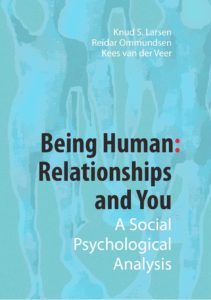Theodor Holman – Opheffer ~ Loop even mee
De Groene Amsterdammer. 5 december 2018.
[…]
We lopen even verder. Daar wonen Ingrid en Linda Bouws. Prachtmeiden. Ze waren ouder dan ik, dus ik begreep meteen dat mijn verliefdheid geen zin had. Onlangs verscheen het oorlogsdagboek van hun grootmoeder Paula Bermann: Deze ontspoorde wereld. Vlak voor het einde van de oorlog wordt Paula verraden en eindigt in Bergen-Belsen, haar kinderen waaronder de moeder van Linda en Ingrid overleven het.
Als ik op het omslag van het boek naar Paula kijk, herken ik Linda en Ingrid.
[…]
Pooyan Tamimi Arab ~ Spinoza, materiële religie en de vreemdeling – Spinozadag 2018
Dr. Pooyan Tamimi Arab is universitair docent religiewetenschappen aan de Universiteit Utrecht. In zijn onderzoek richt hij zich op betwiste afbeeldingen, Islam en religieuze diversiteit in Nederland. In de recente publicatie “Amplifying Islam in the European Soundscape” onderzoekt hij hoe Islamitische geluiden in Nederland de culturele normen uitdagen en in hoeverre deze gereguleerd worden door de Nederlandse grondwet en overheid.
Zie: https://amsterdamsespinozakring.nl/
Zie ook: http://rozenbergquarterly.com/david-kenning-spinoza-philosopher-of-counter-radicalization/
Insulinde en Suriname
Met het imposante slotakkoord van de Max Havelaar, richt Multatuli zich rechtstreeks tot de koning:
‘Want aan U draag ik mijn boek op, Willem den Derden, Koning, Groothertog, Prins… meer dan Prins, Groothertog en Koning… Keizer van ‘t prachtig rijk van Insulinde dat zich daar slingert om den evenaar, als een gordel van smaragd…’
Deze regels horen niet alleen tot de bekendste, mooiste en felste regels uit onze literatuur, maar leverden bovendien twee benamingen op voor Neerlands oudste stuk Derde Wereld. Voordien werd dat aangeduid met Indië (al dan niet met het bijvoeglijk naamwoord Nederlandsch, Oost of beide) en, sinds de roep om zelfstandigheid in de jaren 30 van de vorige eeuw stem kreeg, met Indonesië.
De naam Indonesië is opgebouwd uit Indië en het Griekse nesos, eiland, en betekent letterlijk: eilandenrijk der Indiërs. Hetzelfde achtervoegsel staat in Polynesië, Melanesië en Micronesië, eilandgroepen die ook wel samengenomen worden onder de naam Austronesië.
Indië zelf komt van het Griekse Indos, wat de rivier de Indus betekent; India is dus: het gebied van de Indus. In vroeger tijden werd Indië nogal eens verbasterd tot Inje – bijvoorbeeld in ‘Oost-Injeganger’. Vondel heeft het in een van zijn gedichten over ‘t Gulden Indus.
Weinig literatuurliefhebbers, zelfs als ze aan een Insulindeweg of -laan wonen, zullen zich realiseren dat het door Multatuli geconstrueerde Insulinde dezelfde betekenis heeft als Indonesië: het is een combinatie van het Latijnse insulae (eilanden) en Indi. Het woord vond al tamelijk snel na het verschijnen van de Max Havelaar in 1860 ingang. Geertruida – Truitje – Bosboom-Toussaint noemde in haar roman Majoor Frans (1876) de ‘grote tijgerjagten op Insulinde’; en Justus van Maurik schreef in zijn Indrukken van een totok (1895 – totok is Javaans voor ‘Europeaan’): Het paleis van den Gouverneur-Generaal onderscheidt zich door deftige eenvoud. Mij dunkt voor den onderkoning van Insulinde zou het fraaier hebben mogen zijn.’
De tweede naam die Multatuli voor het gebied bedacht, was een beeldspraak: de gordel van smaragd. Dezelfde overweldigende indruk die de Indonesische natuur op iemand kan hebben, werd door de voormalig Binnenlands Bestuursambtenaar A. Alberts juist kernachtig samengevat met de titel Groen. Het verhaal verscheen in de bundel De eilanden (1952).
Maar Nederland had nog meer Derde Wereld (de uitdrukking ‘Derde Wereld’ veronderstelt twee andere werelden; onder de eerste – of oude – wereld wordt gewoonlijk Europa verstaan, de tweede – Amerika en Canada – heet ook wel de nieuwe wereld, bijvoorbeeld in Antonin Dvořáks symfonie From the New World.
Being Human: Relationships And You ~ A Social Psychological Analysis – Preface & Contents
 Preface
Preface
This book represents a new look at social psychology and relationships for the discerning reader and university student. The title of the book argues forcefully that the very nature of being human is defined by our relationships with others, our lovers, family, and our functional or dysfunctional interactions.
Written in easy to follow logical progression the volume covers all major topical areas of social psychology, with results of empirical research of the most recent years included. A common project between American and European social psychologists the book seeks to build a bridge between research findings in both regions of the world. In doing so the interpretations of the research takes a critical stand toward dysfunction in modern societies, and in particular the consequences of endless war and repression.
Including topics as varied as an overview of the theoretical domains of social psychology and recent research on morality, justice and the law, the book promises a stimulating introduction to contemporary views of what it means to be human.
A major emphasis of the book is the effect of culture in all major topical areas of social psychology including conceptions of the self, attraction, relationships and love, social cognition, attitude formation and behavior, influences of group membership, social influence, persuasion, hostile images, aggression and altruism, and moral behavior.
Table of contents
Introduction
1. The Theoretical Domain and Methods of Social Psychology
2. Cultural and Social Dimensions of the Self
3. Attraction and Relationships: The Journey from Initial Attachments to Romantic Love
4. Social Cognition: How We Think about the Social World
5. Attitude Formation and Behavior
6. The Influences of Group Membership
7. Processes of Social Influence: Conformity, Compliance and Obedience
8. Persuasion
9. Hostile Inter-group Behavior: Prejudice, Stereotypes, and Discrimination
10. Aggression: The Common Thread of Humanity
11. Altruism and Prosocial Behavior
12. Morality: Competition, Justice and Cooperation
References
ISBN 978 90 5170 994 0 – NUR 770 – Rozenberg Publishers – 2008
“Therefore this reading has a rare and valuable feature, that of making a link between American and European social psychology: “Being human: Relationships and you” is an excellent example of how the two lines of thought are actually articulated…it is clearly written, using a professional yet assessable language and therefore easy to read by even the non-specialist public…always pointing to the fact that social psychology is not “just a science” but it deals with issues that constitute the substance of our existence as humans”.
Being Human: Relationships And You. A Social Psychological Analysis ~ Introduction
 The roots of Psychology are international, but so is psychology. A major figure in the history of psychology was the Russian physiologist Ivan Pavlov. The premier pioneer in the study of childhood development was the Swiss biologist Jean Piaget. The father of the psychoanalytic movement was an Austrian medical doctor Sigmund Freud. Modern European social psychology has made major contributions, for example in the field of social categorization theory. Henri Tajfel and his collaborators made signal contributions to the understanding of group behavior during his tenure at Bristol University, as did collaborators from other European countries.
The roots of Psychology are international, but so is psychology. A major figure in the history of psychology was the Russian physiologist Ivan Pavlov. The premier pioneer in the study of childhood development was the Swiss biologist Jean Piaget. The father of the psychoanalytic movement was an Austrian medical doctor Sigmund Freud. Modern European social psychology has made major contributions, for example in the field of social categorization theory. Henri Tajfel and his collaborators made signal contributions to the understanding of group behavior during his tenure at Bristol University, as did collaborators from other European countries.
However, Moghaddam (1987; 1990) described the United States as the “superpower” of academic psychology. In support of this claim he cites the volume of resources available to American scholars. Other observers have also described the US as the major source of academic social psychology, and the “center of gravity” for professional development (Bond, 1988). It would not be inaccurate to state that the vast majority of social psychological research is conducted in North American settings, including Canada. This might therefore be described as the “first world” of social psychology in terms of production and influence on the world scene.
Europe, with Great Britain and France leading in social psychological research, may be considered the second world of social psychology. Generally the university settings are smaller, and funds available not as large as those in the US, but social psychologists in Europe have made distinctive contributions of their own in the development of theory. In particular European scholars give more attention to intergroup behavior (e.g. Doise, Csepeli, Dann, Gouge, Larsen, & Ostelli, 1972), and the wider social context like social structure, and culture (e.g. ideology) (Jaspars, 1980; Doise, 1986). European and some American colleagues tend to criticize American scholars as being too individualistic (e.g. Sampson, 1977) and culture-blind in their orientation, having mainly developed theories that reflect the salient values, goals and issues of the United States that may not be equally valid in other societies, and neglecting other social phenomena like minority influence and social change (Moscovici, 1972).
European social psychologists have developed unique laboratory methodology, the minimal group situation to study the effects of social categorization on intergroup relations (Tajfel, Flament, Billig, & Bundy, 1971), along with observation studies of how people communicate attitudes in natural settings and create shared social representations (Potter and Wetherell, 1987; Van Dijk, 1987; Moscovici, 1981).
The third world of social psychology is found in the developing nations. Psychology in these countries is greatly hampered by lack of funding, and therefore has to rely to a large extent on psychology developed in other countries and cultural settings. There are many problems in these countries, which could benefit from a mature research based social psychology. The social problems of developing countries are to some extent distinctive as they involve issues of poverty, ethnic conflict, and lifestyles very different from the urban lives of the western world (see e.g. Kim, Yang and Hwang, 2006).
In the future we must look to the development of social psychology from all three worlds. There is much in the human experience that we have in common. We are all born into the world as dependent beings, all have to face developmental tasks, including forming families, and finding our social niche. We all face the great existential issues including the transitory nature of life. World psychology can provide insights that are helpful to all societies on these and other problems we all face. There are also specific problems unique to each society and culture. This is where the third world must make its contributions based on patient theoretical development, and empirical research. Reliable and valid empirical findings are superior to any armchair theorizing, regardless of the quality of the theoretical ideas. Only by empirical means can we eventually develop a significant world social psychology. Such a social psychology would describe the processes of social relations, thinking and social influence which would be common to all human beings. May this book be a step toward that noble quest, and stimulate the next generation of students, scholars, and all those interested in the field.
Being Human. Chapter 1: The Theoretical Domain And Methods Of Social Psychology
 Social psychological thinking is ancient, but the science described in these pages is modern. There are those who would say “there is nothing new under the sun”. It is true that we owe a great deal to philosophers like Aristotle, Socrates, Plato and many others, who thought about society, and made astute observations. Later scholars however have since put many of these early ideas, to the empirical test. We all have a cultural heritage to which we are indebted for many contemporary ideas.
Social psychological thinking is ancient, but the science described in these pages is modern. There are those who would say “there is nothing new under the sun”. It is true that we owe a great deal to philosophers like Aristotle, Socrates, Plato and many others, who thought about society, and made astute observations. Later scholars however have since put many of these early ideas, to the empirical test. We all have a cultural heritage to which we are indebted for many contemporary ideas.
However, social psychology as a separate field commenced with the publication of two books at the beginning of the twentieth century. William McDougall was the author of An introduction of Social Psychology published in 1908, and in the same year E.A. Ross published Social Psychology: An outline and source book. McDougall was a psychologist and Ross a sociologist, so it’s right to say that these two fields were the parents of social psychology. In fact, typically social psychology is taught in both fields, but with a somewhat different emphasis.
The major issue confronting those early thinkers was how the influence of others affects our behavior. Social psychology often reflects salient concerns in history, a fact that is easily ascertained by examining the major research topics in a given time period. In the early years of the twentieth century, the French revolution was still in the mind of many social thinkers and therefore social psychology placed an emphasis on such questions as why people behave less rationally in crowds. Le Bon said in affect “as individuals people are civilized, in crowds they are barbarians” (Larsen, 1977, p.iix).
Does the environment cause behavior; for example are some cultures more aggressive and war like than others? (Chagnon, 1997). McDougall felt that social behavior could be explained by social instincts, and therefore favored the “nature” explanation. In turn McDougall was influenced by Charles Darwin whose evolutionary theory proposed that the explanation of behavior is found in its contribution to survival. Others, however, suggested that we learn to behave in altruistic or aggressive ways through imitation of others and by the power of suggestion. For example, William James (1890), another influential pioneer, believed that the primary explanation for social behavior is “habit”; we learn our social behavior through repetition, thus emphasizing “nurture”. John Dewey (1922), another early thinker in social psychology, advanced the idea of the environment as a determinant and emphasized situational influences on behavior. These varying ideas contributed directly to the dominant theories which today influence and direct social psychological research and concepts.
1. Theories in social psychology
These early thinkers proposed major all embracing concepts in turn advocated as explaining all social behavior (Allport, 1985). For example, some proposed that hedonism (pleasure seeking) explain all that we do? Other thinkers suggested that we understand human behavior simply as a function of imitation or instincts. This emphasis on all embracing concepts, introduced the problem of “nominalism” into psychology. Do we really understand more by just labeling behavior? Eventually, social psychologists recognized the inadequacy of all encompassing principles and began the development of theories based on the scientific method.
What defines social psychology as a discipline? Allport (1985) suggested that social psychology is “an attempt to understand and explain how thought, feeling, and behavior of individuals are influenced by the actual, imagined, or implied presence of others” (p.3). In other words, social psychology is the scientific study of social cognition (how people think about each other), how people are influenced by the behavior of others (for example conformity processes), and how they relate to each other through cooperation or aggression.
Some scholars distinguish between a psychological and a sociological version of the discipline (see Hewstone & Manstead, 1995). The latter is said to address more explicitly the interface between the individual and the wider social structure. We think this is an unnecessary and outdated distinction. In fact, Allport also added to his definition that “The term ‘implied presence’ refers to the many activities the person carries out because of his position (role) in a complex social structure and because of his membership in a cultural group”. (Allport, 1985, p. 3). Hence, we agree with Jones (1985) that social psychology is “an excellent candidate for an interdisciplinary field” (p.47). The present book seeks to realize this standpoint. This rationale suggests that the definition of social psychology may be found in the major explanations it has produced of social behavior. This effort resulted in four major theories within psychology, and several within sociology and related social sciences. Read more



